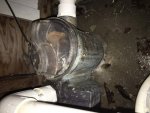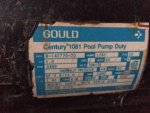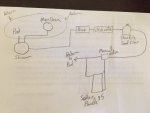- Jul 17, 2015
- 19
- Pool Size
- 15000
- Surface
- Plaster
- Chlorine
- Salt Water Generator
- SWG Type
- CircuPool Core-55
I have a pump that has continued to leak and I'm to the point of just replacing it. Bought the house with the pool last year and have no idea how long the existing pump has been in service, but the casing is cracked where the bolts attach the wet end to the dry end and the seal of the pump housing leaks as well. I was successful last summer with putting silicon caulking on many places to try to stop the leak, but tonight it sprang a brand new leak and was shooting up into the air. Time to replace it as I'm just done with it and would rather have something that works and doesn't take any more time trying to troubleshoot. (in other words, I'd rather be in the pool)
So, could someone help me figure out what to replace the old pump with? Attached are 2 pictures...one of the existing motor info and another of the pump housing (I've already scraped alot of the silicon from the pipe joint on top of the pump). I have no idea what brand it is to start with.


So I'm trying to replace a 1.0 HP pump and with the new pumps out there, not sure I need all that power anymore.
I have a 13,000 Gallon pool with a Sand Filter.
1 1/2 pipe from simmer basket to pump and from pump back to pool.
We heat the pool by diverting the flow to some solar panels on the roof of the house, so we still need to be able to pump water to that height. The pipe to the roof and back is 2 inch.
No water features.
I've read some of the threads on the forum and found information that putting a pump that is too powerful can ruin the sand filter, however with our existing pump, I notice a true difference in water flow as seen in the clear pump lid when the water is being sent to the roof. The sand filter gains pressure as well (up to about 10 lbs) when going on the roof. I assume that is normal but don't really know for sure.
Can someone help me figure out the right type of pump to replace this one? Once I'm done with this, perhaps my existing motor can be moved into the garage...I've always wanted a bench grinder.
thanks,
Patrick Smith
So, could someone help me figure out what to replace the old pump with? Attached are 2 pictures...one of the existing motor info and another of the pump housing (I've already scraped alot of the silicon from the pipe joint on top of the pump). I have no idea what brand it is to start with.


So I'm trying to replace a 1.0 HP pump and with the new pumps out there, not sure I need all that power anymore.
I have a 13,000 Gallon pool with a Sand Filter.
1 1/2 pipe from simmer basket to pump and from pump back to pool.
We heat the pool by diverting the flow to some solar panels on the roof of the house, so we still need to be able to pump water to that height. The pipe to the roof and back is 2 inch.
No water features.
I've read some of the threads on the forum and found information that putting a pump that is too powerful can ruin the sand filter, however with our existing pump, I notice a true difference in water flow as seen in the clear pump lid when the water is being sent to the roof. The sand filter gains pressure as well (up to about 10 lbs) when going on the roof. I assume that is normal but don't really know for sure.
Can someone help me figure out the right type of pump to replace this one? Once I'm done with this, perhaps my existing motor can be moved into the garage...I've always wanted a bench grinder.
thanks,
Patrick Smith


